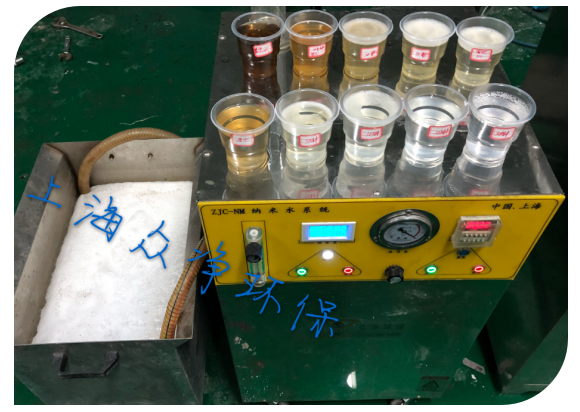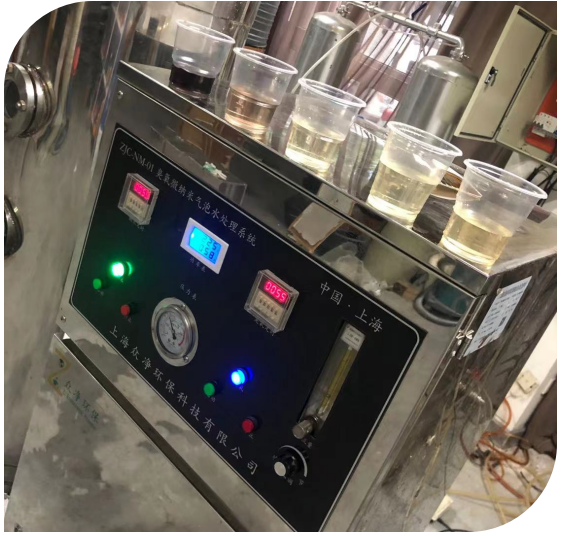Wastewater decolorization method - introduction of ozone micro nano bubble technology
Click:5728Date:2022-02-19 03:29:52
Principle of decolorization of wastewater by ozone nano bubbles
Ozone forms active free radicals (oh ·) in water and reacts with pollutants to break the unsaturated bond in the pigment group and produce intermediate products such as small molecular weight and colorless organic acids and aldehydes, so as to achieve the purpose of decolorization.
Ozone micro and nano bubbles are used to decolorize pigment, which can be conjugated from ozone nano bubbles л- The oxidative decomposition of the electronic system is described. The common basic component of dyes is o-hydroxyazo pigment. When these compounds react with ozone nano bubbles, the first is the electrophilic attack of ozone nano bubbles on Hydrazine propyl (which almost always exists in the solution). For another example, the phenolphthalein of hydroxyphenylmethane pigment can produce color and discoloration through the reversible opening and closing of lactone ring, so it can be used as an indicator. Alkaline phenolphthalein is easy to react with ozone nano bubbles. Ozone nanobubbles conduct 1.3 one addition reaction at the electron rich C = C key, which can cut off the pigment skeleton and decolorize. When ozone nanobubbles react with malachite green of triphenylmethylamine pigment, they attack the nitrogen and carbon skeleton (C = C bond) of dimethylamine at the same time, which is the same as that of phenolphthalein reaction. When the azomethine pigment with C = n bond reacts with ozone nano bubbles, it carries out electrophilic reaction on the nitrogen atom with C = n bond. Ozone nanobubbles attack C = n bond and dimethylamino group to form oxazolidine ring at the same time, and the conjugation is cut off and decolorized.

Micro nano ozone bubble superoxidation equipment is widely used to remove refractory organics in water, which can improve the ratio of BOD to cod and make the wastewater biochemical. Ozone micro nano bubble superoxidation method was used to treat wastewater. Under the condition of alkaline pH, the effect of reducing COD in wastewater is better, and the removal effect of COD in wastewater increases with the increase of micro nano ozone water concentration.
The treatment of wastewater by micro nano ozone bubble oxidation can significantly improve the biodegradability of wastewater. Under the condition of high concentration of alkaline and ozone nano bubbles, the ratio of BOD to cod is better.
Main influencing factors of pH value of wastewater treated by micro nano ozone bubble on oxidation process:
(1) The oxidation capacity of oxygen itself is related to pH value. The oxygen atom in micro nano ozone molecule itself has strong electrophilic or proton characteristics, which directly shows strong oxidation performance. The decomposition rate of micro nano ozone in water increases with the increase of pH value. If the pH is increased by one unit, the decomposition of micro nano ozone will be about three times faster, resulting in more • oh. It can be seen how important it is to produce strongly oxidizing • Oh under alkaline conditions!
(2) The physical and chemical properties of organic matter in wastewater are closely related to pH value.
(3) There is a certain relationship between the absorption rate of micro nano ozone and pH value. Generally, the absorption under alkaline conditions is better than that under acidic conditions.
(4) The change of pH value in the process of micro nano ozone bubble oxidation is mainly reflected in the conditions of neutral (pH = 7) or alkaline (pH > 5). The pH value shows a downward trend with the oxidation process, which is due to the oxidation of organic substances into small molecular organic acids and aldehydes. Therefore, in order to strengthen the micro nano ozonation reaction, the pH value should be adjusted continuously.

When ozone micro nano bubbles are used to treat refractory organic polluted wastewater, under alkaline environmental conditions, using micro nano ozone with low cost, high yield and high concentration can produce more • Oh to participate in pollutant reaction, change its molecular structure and chemical properties and become easily degradable substances, which is more effective and competitive than electrolysis technology. Combined with traditional biochemical processes, It can effectively remove chromaticity and refractory organics and reduce the cost of pollution control. It has a broad application prospect in chemical industry, pharmacy, printing and dyeing and other industries. After the wastewater is superoxidized by ozone micro nano bubbles, the content of refractory phenols and aromatics in the wastewater is also greatly reduced. The less the content of aromatic hydrocarbons in the wastewater, the higher the ratio of BOD to cod, and the better the biodegradability.



 Home
Home

